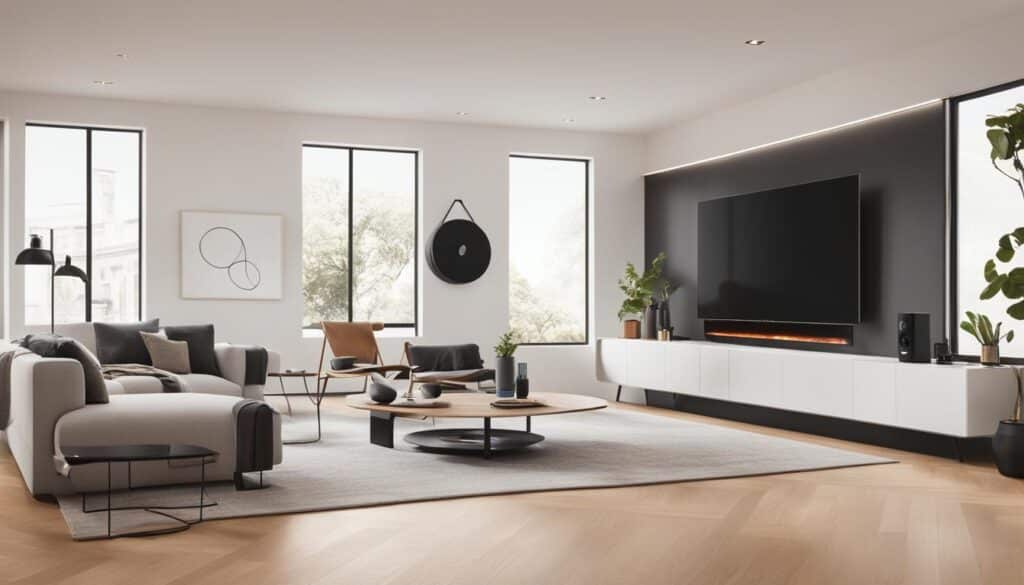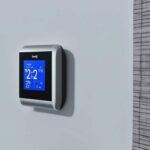Welcome to the world of smart home technology! If you’re looking to upgrade your living space and enjoy the convenience and security it offers, you’ve come to the right place. In this beginner’s guide, I’ll walk you through everything you need to know about smart home technology and how it can enhance your daily life.
Smart home technology has revolutionized the way we interact with our homes. It encompasses a wide range of connected devices that can be controlled remotely through the internet. From voice-controlled assistants to automated lighting and security systems, smart home technology offers a seamless and intuitive way to manage your home.
Table of Contents
Key Takeaways:
- Smart home technology offers convenience, comfort, and enhanced security for homeowners.
- It involves the integration of connected devices that can be controlled remotely through the internet.
- Smart home technology promotes energy efficiency and can help reduce utility costs.
- Popular smart home devices include smart speakers, smart thermostats, and smart lighting systems.
- Getting started with smart home technology requires compatible devices and a central hub for control.
What is Smart Home Technology?
Smart home technology refers to the integration of connected devices and appliances in a home, allowing them to communicate and be controlled remotely through the internet. These devices, often referred to as the Internet of Things (IoT), can include smart speakers, thermostats, lighting systems, security cameras, and more. They are designed to enhance the functionality and convenience of a home, providing automation, energy efficiency, and improved security.
The concept of smart home technology revolves around creating a network of connected devices that can communicate and interact with each other. By utilizing the power of the internet, these devices can be controlled remotely, making our lives easier and more convenient.
One of the key components of smart home technology is the Internet of Things (IoT). The IoT refers to the network of physical devices, vehicles, appliances, and other objects embedded with sensors, software, and connectivity, which enables these objects to connect and exchange data. In the context of smart homes, the IoT allows for seamless communication between devices, enabling homeowners to control and monitor their homes even when they are away.
“Smart home technology allows for seamless communication between devices, enabling homeowners to control and monitor their homes even when they are away.”
Smart home technology offers a wide range of benefits for homeowners. Automation, one of the core features of smart homes, allows for the control of various devices and appliances with ease. For example, you can schedule your lights to turn on and off at specific times or adjust the temperature of your thermostat remotely, ensuring that your home is comfortable and energy-efficient.
Improved Security
Another significant advantage of smart home technology is enhanced security. With smart security cameras, doorbell cameras, and smart locks, you can monitor and control the security of your home from anywhere. Receive real-time alerts on your smartphone if there is any suspicious activity, and even remotely grant access to your home to trusted individuals.
In addition to convenience and security, smart home technology also offers energy efficiency benefits. Smart thermostats, for instance, can learn your daily routines and adjust the temperature settings accordingly, reducing energy waste and saving you money on utility bills.
Smart Home Device Examples
| Device | Description |
|---|---|
| Smart Speaker | A voice-activated device that can play music, answer questions, and control other smart devices in your home. |
| Smart Thermostat | An intelligent thermostat that can regulate your home’s temperature based on your preferences, resulting in energy savings. |
| Smart Lighting System | A system of light bulbs that can be controlled remotely, allowing you to customize the lighting ambiance and save energy. |
| Smart Security Camera | A camera that can be accessed and monitored remotely, providing home surveillance and peace of mind. |
These are just a few examples of the many smart home devices available in the market. As the technology continues to improve and evolve, the possibilities for creating a truly connected and automated home are endless.
In the next section, we will explore the various benefits of smart home technology and delve deeper into how it can enhance your daily life.
Benefits of Smart Home Technology
Smart home technology offers numerous benefits for homeowners. Firstly, it provides convenience by allowing you to control various aspects of your home through a smartphone app or voice commands, eliminating the need for manual switches and controls. Imagine being able to turn on the lights, adjust the thermostat, or lock the doors with just a simple voice command or a tap on your phone.
Secondly, smart home technology promotes energy efficiency by optimizing the use of resources such as lighting and heating. With smart lighting systems, for example, you can schedule lights to turn on and off at specific times, or even adjust the intensity and color to create the perfect ambiance. By using smart thermostats, you can automatically adjust the temperature based on your preferences and occupancy, leading to significant energy savings and a reduced environmental impact.
Lastly, smart home technology enhances home security by incorporating advanced features like surveillance cameras, smart locks, and motion sensors. With a smart security system, you can monitor your home in real-time, receive alerts for any suspicious activity, and even remotely control access to your property. This provides homeowners with peace of mind and a stronger sense of security, knowing that they have reliable protection in place.
Overall, the benefits of smart home technology extend beyond just convenience. It offers energy efficiency and enhanced security, making it a valuable addition to any modern home.
Popular Smart Home Devices
When it comes to creating a smart home, there are a plethora of options to choose from. Here are some of the most popular smart home devices that can elevate your living space:
Smart Speakers
Smart speakers, such as the Amazon Echo and Google Home, have become a staple in many households. These intelligent devices can do much more than just play music. With voice commands, you can ask them questions, control other smart devices in your home, set reminders, and even order products online. They serve as a virtual assistant that can enhance your daily life.
Smart Thermostats
Smart thermostats, like the Nest and Ecobee, bring comfort and energy efficiency to your home. They learn your temperature preferences and adjust accordingly, ensuring you’re always comfortable while saving energy and reducing your utility bills. Through mobile apps, you can control the temperature remotely, making it convenient to warm up or cool down your home before you even step inside.
Smart Lighting Systems
Create the perfect ambiance in your home with smart lighting systems like Philips Hue. These systems allow you to adjust the intensity, color, and timing of your lights with a simple tap on your smartphone or through voice commands. Whether you want bright lighting for productivity or soft, warm hues for relaxation, smart lighting systems offer endless possibilities to create the desired atmosphere.

With these popular smart home devices, you can transform your living space into an intelligent and convenient environment. Whether you want to control your home with voice commands, optimize energy usage, or enhance the lighting ambiance, these devices offer endless possibilities for a connected and comfortable home.
Getting Started with Smart Home Technology
To delve into the world of smart home technology, it’s essential to start on the right foot. This section will guide you through the initial steps of setting up your smart home, ensuring compatibility between devices and the importance of smart home hubs.
When venturing into smart home technology, it’s crucial to ensure that your devices can communicate with each other seamlessly. Many smart devices utilize wireless protocols such as Zigbee or Z-Wave for inter-device communication. This compatibility enables your devices to work together harmoniously, creating a cohesive and efficient smart home ecosystem.
However, compatibility extends beyond the devices themselves. To centralize control and management of your smart home setup, smart home hubs play a vital role. These hubs act as a central control point, allowing you to manage multiple devices through a single dedicated application. Brands like Samsung SmartThings and Apple HomeKit offer reliable smart home hub options that ensure a streamlined and convenient experience.
To optimize your smart home setup and create a smooth user experience, it’s essential to research and choose devices and hubs that are compatible with each other. This research will help you avoid potential frustrations and compatibility issues that may arise.
Key Considerations for Getting Started:
- Ensure device compatibility: When selecting smart home devices, confirm that they are compatible with one another.
- Research wireless protocols: Familiarize yourself with wireless protocols like Zigbee and Z-Wave, as they are commonly used for inter-device communication in smart homes.
- Select a suitable smart home hub: Choose a smart home hub from reputable brands, such as Samsung SmartThings or Apple HomeKit, that meets your requirements and supports the devices you plan to incorporate into your smart home ecosystem.
By following these guidelines and considerations, you’ll be well on your way to setting up a smart home that effortlessly integrates compatible devices through a central hub. This foundation will pave the way for a truly smart, efficient, and connected living space.

Privacy and Security Considerations
With the increasing connectivity of smart home devices, privacy and security have become important considerations. As we integrate more smart devices into our homes, it is crucial to protect our personal data and ensure that our smart home systems are secure.
To safeguard your data, there are several measures you can take. Firstly, it’s important to use strong passwords for your smart home devices and regularly update them. This helps to prevent unauthorized access and ensures that your data remains protected.
In addition to strong passwords, regularly updating firmware on your smart devices is essential. Manufacturers often release firmware updates to address security vulnerabilities and improve overall system performance. By keeping your devices up to date, you can enhance their security and protect your data.
Another important aspect of privacy and security in smart homes is the use of secure networks. When setting up your smart home system, make sure to use a secure Wi-Fi network with a strong encryption protocol, such as WPA2. This helps prevent unauthorized access to your smart devices and ensures the privacy of your data.
“Protecting your data in a smart home environment goes beyond passwords and secure networks. It’s crucial to research the privacy and data protection policies of smart device manufacturers. Choose reputable brands that prioritize user privacy and have robust security measures in place.” – Amy Thompson, Data Privacy Expert
By researching the privacy and data protection policies of smart home device manufacturers, you can make informed choices about the devices you bring into your home. Look for reputable brands that prioritize privacy and have a track record of implementing robust security measures.
Remember, safeguarding your privacy and security in a smart home environment requires a proactive approach. By following best practices, such as using strong passwords, updating firmware, and selecting secure networks, you can enjoy the benefits of smart home technology while ensuring the protection of your personal data.
Key Takeaways:
- Protect your data by using strong passwords for smart home devices.
- Regularly update firmware on your smart devices to enhance their security.
- Use a secure Wi-Fi network with strong encryption protocols to prevent unauthorized access.
- Research the privacy and data protection policies of smart device manufacturers.
- Choose reputable brands that prioritize user privacy and have robust security measures in place.
Smart Home Integration and Expansion
As you become familiar with smart home technology, you may want to expand and integrate more devices into your home automation system. Many devices and hubs offer compatibility with other smart home ecosystems, allowing you to connect and control multiple devices from different manufacturers.
By expanding your smart home, you can enhance its functionality and enjoy a seamless integrated experience. Whether it’s adding smart lights to create ambience or installing smart security cameras for added protection, the possibilities are endless. Integration allows you to control all your devices from a central hub or smartphone app, giving you complete control over your home.
To ensure compatibility between devices, it’s important to consider the different protocols and standards they use. Common protocols include Zigbee and Z-Wave, which enable devices to communicate with each other. Checking for compatibility before purchasing new devices will ensure they integrate smoothly with your existing setup.
Furthermore, staying informed about the latest developments in smart home technology is essential. New devices and features are constantly being introduced, offering even more possibilities for integration and expansion. By keeping up with the latest trends, you can make informed decisions and choose devices that will easily integrate into your smart home ecosystem.
Remember, smart home integration and expansion is about creating a personalized and convenient living space that adapts to your needs. Take the time to explore different devices, compare features, and plan your expansion strategy. Whether you start small and gradually add more devices or go all-in with a comprehensive home automation system, the choice is yours.
Benefits of Smart Home Integration and Expansion:
- Enhanced functionality and convenience
- Centralized control over multiple devices
- Customization and personalization
- Improved energy efficiency
- Enhanced home security and peace of mind
Example of Smart Home Integration:
| Device | Manufacturer | Compatibility |
|---|---|---|
| Smart Speaker | Amazon | Compatible with various smart devices and voice assistants |
| Smart Thermostat | Nest | Works with other Nest products and compatible with Google Assistant |
| Smart Lighting System | Philips | Designed to work seamlessly with Philips Hue bulbs and accessories |
Conclusion
Smart home technology offers a world of convenience, energy efficiency, and enhanced security for homeowners. By understanding the basics of smart home technology, exploring popular devices, and considering privacy and security measures, you can confidently upgrade your living space and enjoy the benefits of a smart home.
Starting small with a smart speaker or diving into a complete home automation system, the possibilities are endless. With smart devices like Amazon Echo and Google Home, you can control your home with just your voice. Smart thermostats like Nest and Ecobee ensure optimal comfort and energy savings, while smart lighting systems like Philips Hue create the perfect ambiance for any occasion.
However, as you embrace the future of living, it is important to prioritize privacy and security. Protect your personal data by using secure networks and choosing reputable smart home device manufacturers that prioritize user privacy. Stay informed about the latest developments in smart home technology and choose devices that can easily integrate into your existing setup.
Upgrade your living space with smart home technology and experience the convenience, energy efficiency, and enhanced security it has to offer. Create a smart home that suits your lifestyle and needs, and enjoy the benefits of a connected and automated living space.
FAQ
What is smart home technology?
Smart home technology refers to the integration of connected devices and appliances in a home, allowing them to communicate and be controlled remotely through the internet.
What are the benefits of smart home technology?
Smart home technology offers convenience by allowing you to control various aspects of your home through a smartphone app or voice commands. It also promotes energy efficiency and enhances home security.
Which smart home devices are popular?
Some popular smart home devices include smart speakers, smart thermostats, and smart lighting systems.
How can I get started with smart home technology?
To get started, ensure that your devices are compatible with each other and can connect to a central hub. Research and choose devices and hubs that are compatible with each other to create a seamless smart home experience.
What should I consider in terms of privacy and security in a smart home?
It is crucial to protect your personal data by ensuring that your smart home devices are secure and have proper measures in place to protect against unauthorized access. Use strong passwords, regularly update firmware, and use secure networks. Choose reputable brands that prioritize user privacy.
How can I expand and integrate more devices into my smart home system?
Many devices and hubs offer compatibility with other smart home ecosystems, allowing you to connect and control multiple devices from different manufacturers. Stay informed about the latest developments and choose devices that can be easily integrated into your existing setup.
Source Links
- https://www.kake.com/story/50305501/golden-state-warriors-forward-draymond-green-reinstated-after-12-game-suspension
- https://techannouncer.com/indian-visa-process-for-japanese-citizens-a-comprehensive-guide/
- https://www.linkedin.com/pulse/ai-web-core-review-price-otos-truth-exposed-md-minhajul-islam-tyqoc?trk=article-ssr-frontend-pulse_more-articles_related-content-card


